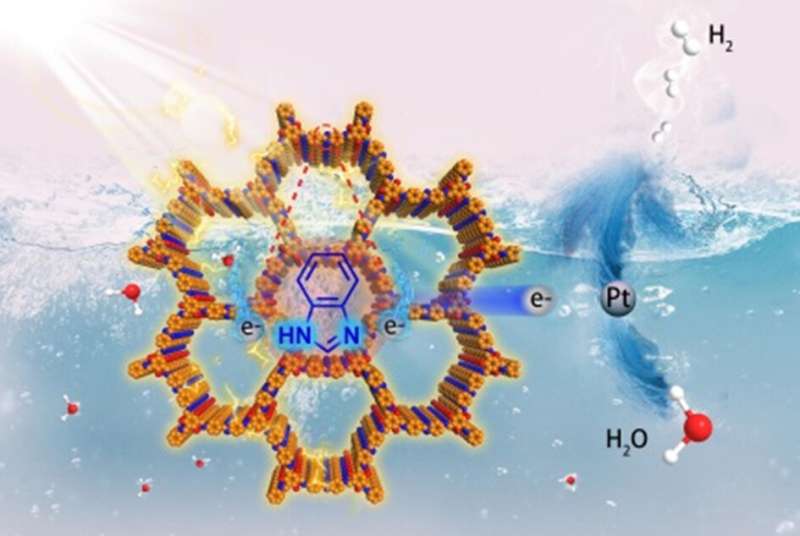This article has been reviewed according to Science X's editorial process and policies. Editors have highlighted the following attributes while ensuring the content's credibility:
fact-checked
trusted source
proofread
Team constructs highly active covalent organic framework from benzimidazole monomer in solvothermal pathway

Hydrogen (H2) is a clean carbon-free fuel with high gravimetric energy density and emerges as an attractive alternative to the unrenewable fossil resource. Photocatalytic water splitting over a semiconductor provides a promising economical and environmentally friendly route to convert unlimited solar energy to H2.
The light-driven hydrogen evolution reaction (HER) involves light-harvesting, charge separation and transport, and surface proton reduction. The slow multi-electron interfacial proton reduction usually occurs within milliseconds or longer, while the photoexcited state typically relaxes and returns to the ground state via radiative or irradiative recombination within a few picoseconds. The formation of abundant long-lived electrons with timely transport to reactive sites for the proton reduction is regarded as a key issue for HER but remains a challenge for designing photocatalysts.
Recently, a research team led by Prof. Yu Zhou and Prof. Jun Wang from Nanjing Tech University, China, reported the construction of a highly active covalent organic framework (COF) from an unusual benzimidazole monomer in a microwave-assisted solvothermal pathway. The results are published in Chinese Journal of Catalysis.
Co-catalysts are typically involved in HER to accelerate electron-to-proton transfer. COFs offer a versatile affinity to modulate and stabilize co-catalysts and maximize their efficiency, particularly for noble metal co-catalysts like Pt single atoms. Strategies such as pre-designation, post-modification, and hybridization with other materials have been employed to develop COF-based photocatalysts for HER.
However, the function of COFs is strongly dependent on the building blocks, making the synthesis and structure modulation via monomer designation crucial. Although COFs have been typically synthesized from highly symmetric and rigid building blocks, the use of asymmetric monomers may greatly enrich the variety, physicochemical properties, and functions of COFs. Nonetheless, the intrinsic mismatch between the isotropy of crystal and the anisotropy of asymmetric building blocks poses a challenge in synthesis. While COFs containing asymmetric monomers have been used in the field of gas adsorption and fuel cells, they have not yet been applied in the field of photocatalysis and metal-supported catalysts, particularly monoatomic catalysts.
With single-atom Pt sites as the cocatalyst, the benzimidazole-based COF exhibited a high HER rate up to 115 mmol g-1 h-1 and turnover frequency of 4475.1 h-1 under visible-light irradiation. The above performance relied on the combinational effect of benzimidazole moieties and COF framework, which, on the one hand, stabilized photogenerated electrons to prolong the electron lifetim; and on the other hand, provided a strong host-guest interaction that resulted in the creation of single-atom Pt sites and the acceleration of the electron-transfer to the Pt active sites for proton reduction.
This work demonstrates the perspective in the construction of electron stabilization and interfacial charge transfer avenue for the HER process, which can be reached by a molecular-level design of COF-based organic semiconductors by using structural and functional diverse asymmetric building blocks.
More information: Fangpei Ma et al, Benzimidazole-based covalent organic framework embedding single-atom Pt sites for visible-light-driven photocatalytic hydrogen evolution, Chinese Journal of Catalysis (2023). DOI: 10.1016/S1872-2067(23)64422-5
Provided by Chinese Academy of Sciences





















